#errol ottus
Explore tagged Tumblr posts
Text
2017: #8-STRANGE MONSTERS FROM ART

Pandora’s Box issues forth a tale each year about monsters in different mediums. We have previously examined monsters in everything from books, to comics, to even songs (see 2016: #6-STRANGE AND DANGEROUS MONSTERS FROM BOOKS, 2013: #3-STRANGE COMIC BOOK MONSTERS, and 2014: #4-STRANGE MONSTERS FROM SONGS). Art, specifically paintings, woodcuts, and statues, offer a wealth of monstrous possibilities. Horror specifically about art is best seen with Rod Serling’s The Night Gallery tv series which was about spooky paintings which each told a tale. Ray Bradbury’s book and film, The Illustrated Man, was about tattoos that each depicted a future event. Many horror films have paintings with false peek eye holes. Sometimes monsters in paintings come alive such as in the recently released It and the evil nun in The Conjuring 2. The Dark Shadows tv series often featured paintings, from old paintings of unaging vampires to Dorian Gray inspired paintings (see 2016: #7-GUIDE TO DARK SHADOWS). Jack Nicholson as The Joker in 1989’s Batman walked through an art gallery and said, “I don’t know about art, but I know what I like (see 2017: #10-SUPERHEROES).
There is a lot of spooky art perfect for Halloween. The Greeks had artwork of mythological figures, and the Middle Ages presented paintings of Death personified. In 1505, Hieronymous Bosch completed the triptyche, The Garden of Earthly Delights, which features three panels representing the Garden of Eden, the garden of earthly delights, and Hell (see above image). I particularly like the Hell panel, and it is perhaps my favorite painting. There are many monsters and horrors that inhabit Bosch’s landscape of Hell. There are giants rats tearing apart knights, and creeping about are bird-men, fish-men, and even crocodile-men. One particular marching crocodile-man is my favorite figure in the painting, and I would love to know what Bosch would say his story would be (see below).
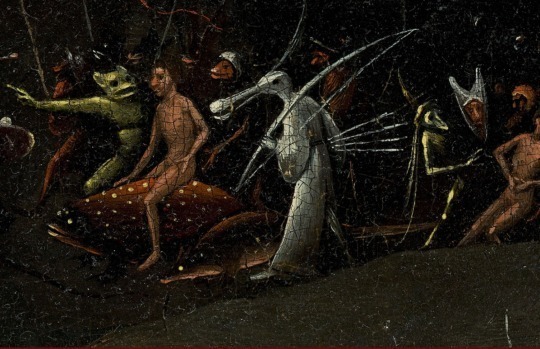
The painting also includes armies, descending moons, fiery pits, and giant human bodily organs converted into objects including rooms. Similar hellish work to Bosch’s was released in the 1600’s by Jacob Isaacsz. van Swanenburg as seen with his The Harrowing of Hell (see below).

Henry Fuseli’s The Nightmare from 1793 produced a perturbed imp and a demonic horse (see below). Freud kept a reproduction of that painting in his apartment in Vienna.

Perhaps the most recognizable horror-related painting is Edvard Munch’s The Scream (see below). The Scream is a series of four paintings Munch painted between 1893 and 1910. They were inspired by a red sunset that Munch felt like was a scream of nature.

In 1915 the interesting artistic movement of Dadaism developed, and Dadaists created all sorts of odd art demonstrating the absurdity of life. Max Ernst produced a forest of woodcuts and paintings that include chairs entirely made out of human bones, flying god-heads, half-human absurd abominations, and an ominous elephant-like monster in his The Elephant Celebes from 1922 (see below). Ernst spent time as a child with fevers staring at patterns in wood grain, similar to Salvador Dali’s paranoiac-critical method (see 2016: #10-MONSTERS ON THE LOOSE 7).
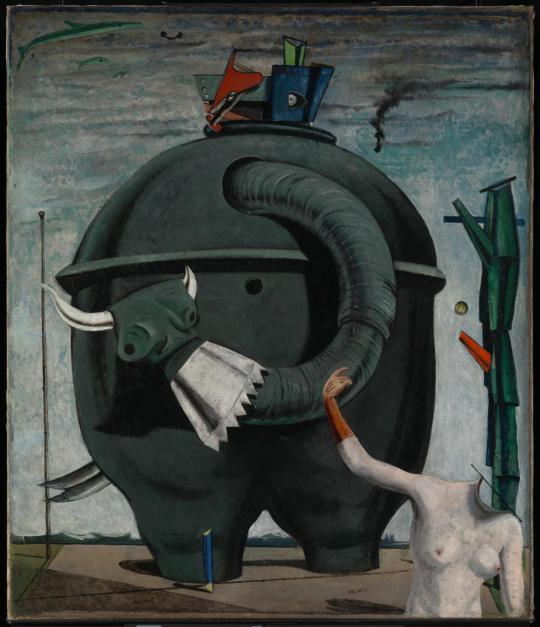
Dadaism formed into Surrealism, and Dali’s work has all sorts of melting monstrosities, flaming giraffes, and the like. Dali’s Paint-Maker’s Plight from 1941 shows an eyeball humanoid similar to costume’s worn by The Residents (see below and 2012: #1-SPOOKY MUSIC).
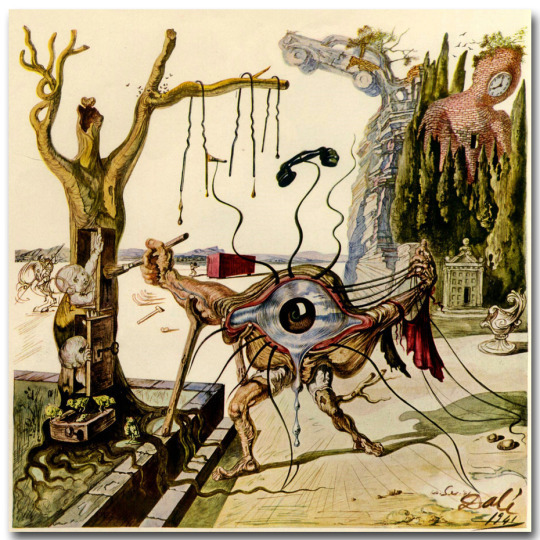
In 1954 Francis Bacon painted the dark, Figure with Meat, which features a grotesque pope seated between a grossly bisected cow (see below). In 1989’s Batman, Nicholson’s Joker sees Figure with Meat in the art gallery scene and stops to comment that he likes that one.

In 1967 Picasso’s untitled Chicago statue was dedicated, and it is a monster that most resembles an Afghan Hound (see below). I frequently walk past it, but it sure does not bark or growl; too bad it doesn’t.
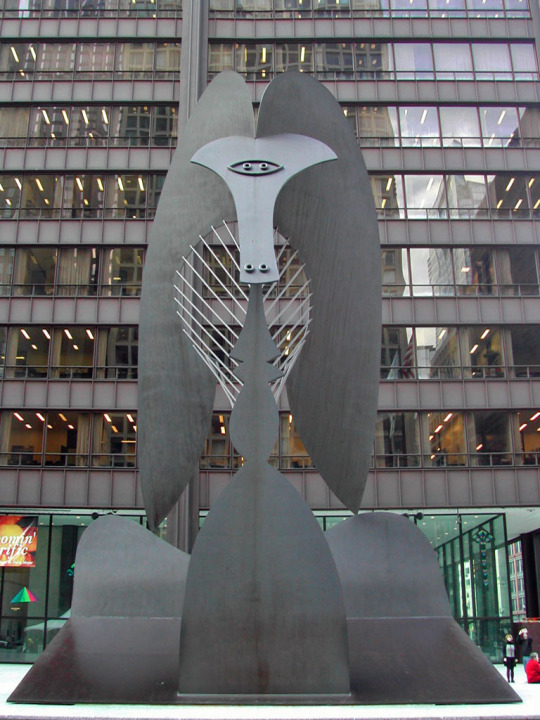
Surely the cherry, or bloody bit, on the horror cake is Otto Rapp’s Deterioration of Mind Over Matter from 1973 which features a rotting human head melded with a bird cage (see below).

In the last fifty years there have been many artists that have specialized in painting or drawing monsters. Frank Frazetta created scores of fantasy paintings especially Conan the Barbarian related artwork (see below).

Boris Vallejo still releases sword and sorcery artwork as well artwork depicting superheroes (see below and 2017: #10-SUPERHEROES).

Bob Eggleton, Larry Elmore, and Erol Otus release artwork that is oriented towards Dungeons & Dragons (see below for Erol Otus artwork). Wayne Barlowe has released paintings of aliens, monsters, and even devils. There is so much available art of monsters, that we must mix them all up in the churning cauldron of creepiness and watch the three best monsters crawl out.
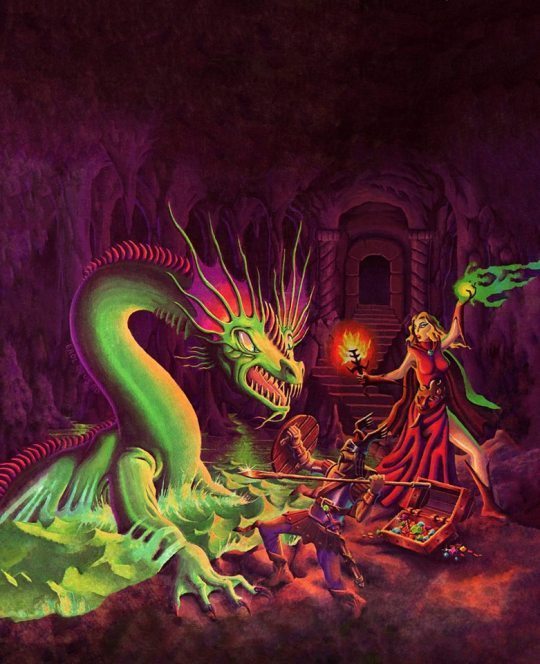
Salvador Dali certainly is an artist who can contribute one of the three strangest monsters appearing in art, but which one? He produced artwork more surreal than the world had ever seen. Dali had so many monsters appearing in paintings, it is hard to decide which is his best. His work contains quite a few stretched out or melting people, often just huge heads held up by supports. But those are not monsters. He featured a titan bursting out of our planet in one painting and an elongated black ghost of Vermeer in another. His 1936 painting, Soft Construction with Boiled Beans (Premonition of Civil War) features a large monster that is the definitely the first to bubble out of the cauldron of creepiness (see below). The unnamed monster represents civil war. It is a weird collection of limbs, and seeing it travel through the desert landscape it is painted in would be fascinating. It appears to be dismantling itself or removing its own limbs, and it represents self-destruction.
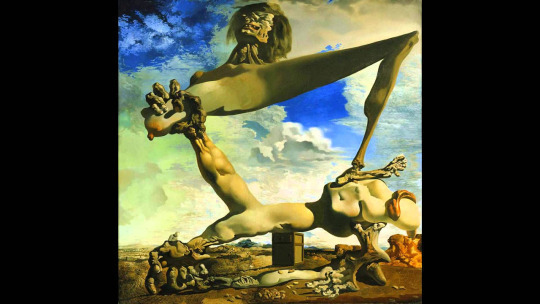
The second painter identified by the cauldron of creepiness is Ivan Albright. Ivan Albright is a painter who used a very distinctive type of magical realism in his work. His dark paintings show wrinkles upon luminescent wrinkles, cracks, scratches, edges, and the effects of entropy. His work is both disturbing and mesmerizing (see 2016: #3-BLOODY MESMERISM). His incredibly detailed painting, The Door, is almost as large as a full sized door, and it looks like a door to the Outer Limits (see 2017: #3-GUIDE TO THE OUTER LIMITS). But that isn’t a monster. Surely his best artistic contribution to the imagery of monsters is from his 1943 painting, The Picture of Dorian Gray (see below). This painting was commissioned for the The Picture of Dorian Gray film with Angela Lansbury from 1945. The black and white film switches to color when the painting is shown. If you ever have the opportunity to see this painting, do so; it is located at Chicago’s Art Institute. It is a large painting, with blood dripping off of Dorian Gray’s hands and psychedelic, magical colors dripping all over the place like 1969 Haight Asbury. The animistic depth and detail of the painting are incredible. Dorian Gray looks like he could turn you to stone like a medusa if you met his gaze (see 2013: #2-MEDUSAS).
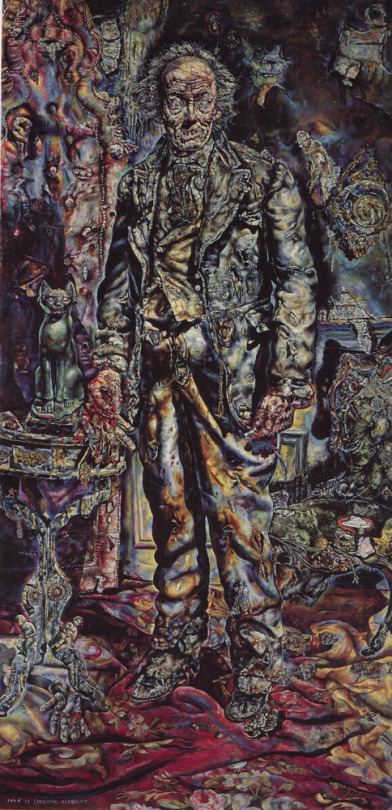
The third artist suggested by the cauldron of creepiness is that of H.R. Giger. His work is dark, often grey, and with sexual and cyborg themes. His 1976 painting, Necronim IV is definitely his most influential work and contains his greatest and famous monster (see below). The monster is what inspired the design for the Xenomorph alien species in the popular science-fiction horror series, Alien. There were four original Alien films, two recently made interesting prequel films, and two Alien vs Predator films. I doubt Giger knew when he painted Necronim IV that it would have the greatest name recognition for the word, alien.

If the cauldron of creepiness issued forth these three monsters from art in the flesh, and they fought to the death, which would win? Boiled Beans, Dorian Gray, or Necronim? It would be hard to find a suitable arena that Dali’s Boiled Beans monster could fit into. Perhaps a large Greek arena would suffice. I expect Boiled Beans would stand there – barely – hopefully cognizant of the proceedings and demonstrating some form of sensory awareness. Dorian Gray would very slowly saunter forward, and each step he took would age the place rapidly like it was being contaminated as in the film, Silent Hill. The Necronim would move faster than the other two, and would swiftly scamper to the center of the arena, releasing a cold alien hiss. That would get Boiled Beans attention who would start to shake and move. The Necronim would attack Boiled Beans since it is a larger perceived threat than Dorian Gray. The Necronim would attach itself to the mammoth leg of Boiled Beans and start madly scratching and tearing like a rabid black cat. Blood would gush, possibly not normal blood – but blood made of boiled beans! Boiled Beans would get in one powerful punch on the Necronim sending it across the arena crashing into the stone stands, sending rock splinters scattering. Dorian would still be slowly sauntering to the center, very detached. Boiled Beans vicious blow to the Necronim would cause himself to collapse, with his limbs appearing as a mass of trees falling down simultaneously. Due to Boiled Beans self-destructive nature, as the dust settled it would be revealed that the large monster died upon collapsing to the ground by being crushed by its own hefty limbs. The Necronim would inspect Boiled Beans confirming its death before proceeding to Dorian Gray who was still approaching. The Necronim would be all over Dorian Gray, tearing him to pieces in a bloody blur! Dorian Gray was already going to pieces, and a Xenomorph would wipe him out, with his arms and legs flying off all over the place. But the Necronim would not strut away from the battle as a survivor. The glowing energies of Dorian Gray would have touched the Necronim… entropic energies. The Necronim would rapidly rot like it had been aged many decades, and it would burst with its alien acid blood spraying and sizzling. As the acid fumes filled the air, Dorian Gray’s limbs would reattach and he would stand back up. The power that kept Oscar Wilde’s Dorian Gray going was a wish that very much behaved as if he had sold his soul to the devil. Dorian Gray would walk away from the mass of Boiled Beans and the fuming Necronim and smile… then his lips would fall off.
#hieronymusbosch#salvador dali#picasso#garden of earthly delights#henry fuseli#edvard munch#max ernst#francis bacon#otto rapp#frank frazetta#errol ottus#boris vallejo#ivan albright#hr giger#Halloween
11 notes
·
View notes